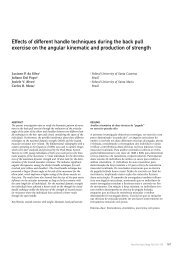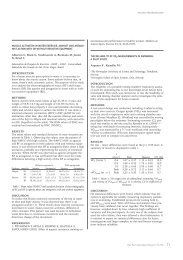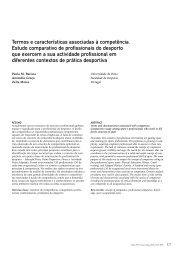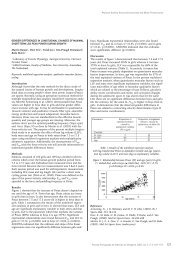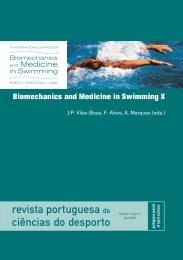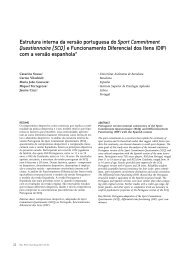adapted swimming sports and rehabilitation
adapted swimming sports and rehabilitation
adapted swimming sports and rehabilitation
Create successful ePaper yourself
Turn your PDF publications into a flip-book with our unique Google optimized e-Paper software.
As a result of factor analysis 4 factor-components of relevance<br />
provide indications for organizing swim <strong>rehabilitation</strong> programs<br />
with a special view to movement co-ordination. Table 2<br />
gives on overview of the specific movement parameters of each<br />
relevant factor-component. The variance of the factor-components<br />
are: 30% for time-structure, 18% for velocity-regime,<br />
10% posture of upper part of the body, 8% for angle of attack<br />
of thigh. The verification of reliability of the factors showned<br />
good internal consistencies (Cronbachs Alpha from .62 to .89).<br />
All main items may be evaluated as strong to very strong<br />
regarding selectivity <strong>and</strong> being greater than the limiting value<br />
of .4 (.55-.99).<br />
Table 2. Loading of main items of each factor-component .<br />
Factor: time-structure Factor-load<br />
duration of leg movement .93<br />
duration of arm movement .92<br />
movement frequency of the legs .92<br />
movement frequency of the arms .92<br />
duration of propulsion-pause between main<br />
phase of the arms <strong>and</strong> main phase of the legs .87<br />
duration of propulsion-pause between main<br />
phase of the legs <strong>and</strong> main phase of the arms .78<br />
Factor: velocity parameters Factor-load<br />
mean velocity of the hip in main phase of the arms .92<br />
maximum velocity of the hip during arm stroke .91<br />
maximum velocity of the hip during leg stroke .90<br />
maximum velocity of the foot during leg stroke .74<br />
Factor: posture of upper part of the body Factor-load<br />
angle of attack of hip-shoulder-water surface<br />
during to start main phase of the legs .96<br />
angle of attack of hip-shoulder-water surface<br />
at the end of main phase of the arms .94<br />
angle of attack of hip-shoulder-water surface<br />
at the end of main phase of the legs .89<br />
angle of attack of hip-shoulder-water surface<br />
during to start main phase of the arms .88<br />
Factor: angle of attack of thigh Factor-load<br />
angle of attack of thigh at the end of main<br />
phase of the legs .84<br />
angle of attack of thigh during start of main<br />
phase of the legs .81<br />
angle of attack of thigh-water surface during start<br />
of main phase of the legs .69<br />
angle of attack of thigh-water surface at the end<br />
of main phase of the legs .65<br />
DISCUSSION<br />
Based on kinematic analysis of time-discrete parameters during<br />
breaststroke in patients with CAD the movement path of the<br />
arms <strong>and</strong> legs <strong>and</strong> of the hip, the duration of pause between<br />
the movements of the extremities <strong>and</strong> the angle of attack of<br />
hip-shoulder-water surface are of crucial importance to forward<br />
speed. These findings are supported by the findings of factor<br />
analysis where comparable parameters were found to be of relevance.<br />
Results indicated large individual variations in timecontinuous<br />
characteristics. The PSQ as a good predictor for<br />
load specific adaptations related to movement co-ordination.<br />
When compared to the findings on healthy volunteer’s from<br />
Blaser (1) or for elite swimmer by Witte (13) different values<br />
were observed. The values in CAD-patients are usually larger<br />
ADAPTED SWIMMING SPORTS AND REHABILITATION<br />
with no differences between arms <strong>and</strong> legs. Therefore the<br />
majority of CAD-patients are not able to react to increasing<br />
loads adequately. Patients who were not able to change the<br />
PSQ-values under increasing external loads might be increasing<br />
their cardiac stress. The movement patterns of CAD-patients<br />
react in diverse ways to increased loads. Based on these findings<br />
the importance of movement analysis in <strong>swimming</strong> of<br />
CAD-patients was underlined in order to guarantee an <strong>adapted</strong><br />
sport-specific <strong>rehabilitation</strong> program as an additional way to<br />
control the load-stress situation <strong>and</strong> to develop movement<br />
skills.<br />
REFERENCES<br />
1. Blaser P (1993). Charakteristik der Koordinationsstruktur<br />
zyklischer Bewegungen bei unterschiedlicher psycho-physischer<br />
Beanspruchung im Schwimmen (Co-ordination of cyclic<br />
movements with different velocity under psycho-motor loads<br />
in <strong>swimming</strong>). Deutsche Sporthochschule Köln:<br />
Forschungsbericht<br />
2. Bücking J, Wiskirchen G, Puls G (1991). The increase of cardiac<br />
output by immersion in water measured by transesophageal<br />
echocardiography. European Journal of Physiology,<br />
419: 109-113<br />
3. Costill DL, Maglischo EW, Richardson AB (1992).<br />
Swimming. Oxford: Mayfield Publishing Company<br />
4. Federle S (1991). Schwimmtechnik (Swim-Technique). In<br />
Pfeifer H (ed.). Schwimmen. Berlin: Sportverlag, 65-94<br />
5. Hanna RD, Sheldahl LM, Tristani FE (1993). Effect of<br />
enhanced preload with head-out water immersion on exercise<br />
response in men with healed myocardial infarction. American<br />
Journal of Cardiology, 71: 1041-1044<br />
6. Hotteling H (1933). Analysis of a complex of statistical variables<br />
into principal components. Journal of Educational<br />
Psychology, 24: 498-520<br />
7. Kelly TL (1935). Essential traits of mental life. Harvard<br />
Stud. in Educ. 26. Cambridge, Mass.: Harvard Univ. Press<br />
8. McMurry RG, Fieselmann CC, Avery KE, Sheps DS (1988).<br />
Exercise hemodynamics in water <strong>and</strong> on l<strong>and</strong> in patients with<br />
coronary artery disease. Journal of Cardiopulmonary<br />
Rehabilitation, 8: 69-74<br />
9. Meyer K, Bücking J (2004). Exercise in Heart Failure: Should<br />
Aqua Therapy <strong>and</strong> Swimming be allowed? Med Sci Sports<br />
Exerc, 36: 2017-2023<br />
10. Schramm E. (1987). Hochschullehrbuch Sportschwimmen<br />
(University textbook of Sport Swimming. Berlin: Sportverlag<br />
11. Weston CF, O´Hare JP, Evans JM, Corrall RJ. (1987).<br />
Haemodynamic changes in man during immersion in water at<br />
different temperatures. Clin Sci, 73: 613-616<br />
12. Wieg<strong>and</strong>, K, Wuensch, D, Jaehnig, W (1975). The division<br />
of <strong>swimming</strong> strokes into phases, based upon kinematic<br />
parameters. In Lewillie, L, Clarys, JP (eds.), Swimming II (pp.<br />
161-166). Baltimore: University Park Press<br />
13. Witte K, Bock H, Strob U, Blaser P (2003). A synergetic<br />
approach to describe the stability <strong>and</strong> variability of motor<br />
behavior. In: Tscharner W, Dauwalder JP (eds.). The dynamical<br />
systems approach to cognition. New Jersey, London, Singapore:<br />
World Scientific, 133-144.<br />
Rev Port Cien Desp 6(Supl.2) 351-357 357



